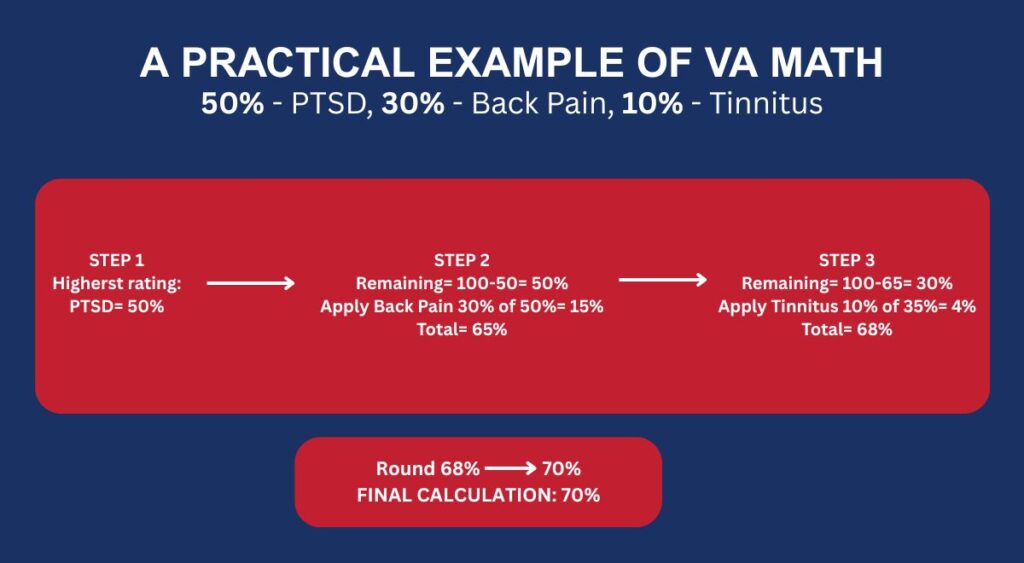Figuring out your VA disability benefits can feel confusing, especially when you have multiple service-connected conditions. You might wonder how the VA combines these individual disability ratings. It is not simple addition, a fact that surprises many veterans navigating the system for disability compensation. Understanding How the VA Calculates Combined Disability Ratings Uses the VA math formula to explain how multiple ratings combine is fundamental. This knowledge helps you understand your final combined disability rating and what it means for your monthly compensation.
This article will explain the VA’s unique method for calculating combined ratings, often called VA math. Knowing how the VA math formula works can make a big difference in comprehending your overall disability picture. It will also help you determine combined va disability ratings for yourself, giving you a better grasp of your potential benefits.
A VA disability rating represents the average impairment in earning capacity resulting from a service-connected condition. It is expressed as a percentage, ranging from 0% to 100%, typically in 10% increments. The Department of Veterans Affairs (VA) uses its Schedule for Rating Disabilities (VASRD), found in Part 4 of Title 38, Code of Federal Regulations, to assign these percentages. The VASRD lists numerous medical conditions and the specific criteria, including symptoms and functional limitations, used to determine the appropriate disability rated percentage for each.
Each condition successfully claimed as service-connected receives its own individual disability rating. This rating reflects the severity of that specific ailment and its impact on your daily life and ability to work. When a veteran has more than one service-connected disability, the VA must then calculate a combined disability rating to reflect the overall level of disability.
Understanding your individual disability ratings is the first step before looking at how they are combined. Accurate medical evidence supporting the severity of each service-connected condition is crucial. The more detailed and accurate this information, the more precisely the VA can assign initial ratings that then feed into the combined rating calculation.

Why a Combined Rating? The VA’s View
The VA does not simply add your disability percentages together. If they did, it would be possible for ratings to quickly exceed 100%, which, under their system, is illogical. Instead, the VA’s approach to combining multiple disability ratings is based on the “whole person theory”. This theory considers a veteran to be 100% whole or 100% efficient before any disabilities.
Each service-connected disability reduces this level of wholeness or efficiency. The VA calculates the combined disability rating by determining how much efficiency you retain after accounting for each disability. This approach is designed to reflect the cumulative impact of multiple conditions on your overall health and ability to function, rather than treating each disability in complete isolation. This method underpins how the VA decides your total VA disability picture.
This perspective means that a subsequent disability is applied to a person who is already considered partially disabled. The effect of an additional disability is measured against the remaining health or efficiency, not the original 100%. This is a core concept in understanding VA rating math.
The Famous “VA Math”: It Is Not Regular Math
Many veterans find themselves perplexed by “VA Math,” a term coined for the VA’s unique method of combining disability ratings. It’s notorious for not being straightforward. For example, a veteran with a 50% disability rating for one condition and another 50% rating for a second condition will not have a combined rating of 100%. This is often the most significant point of confusion and surprise for those new to the VA disability system.
Instead of simple addition, the VA’s method considers the body’s remaining ability. Each new disability rating is applied to the percentage of health or efficiency that remains after accounting for previous disabilities. So, a second disability impacts an individual already partly impaired, and the VA rating math is designed to reflect this diminishing efficiency with each additional disability rated.
This system of combined ratings is fundamental to how the VA assesses overall impairment. While it can seem complicated, understanding the logic behind it helps demystify the process of how your final disability rating is determined. Grasping this rating math is essential for veterans with multiple service-connected disabilities.
How the VA Calculates Combined Disability Ratings Uses the VA math formula to explain how multiple ratings combine
Let’s get into the specifics of the VA’s formula for calculating a combined disability rating. While it might appear complex initially, breaking it down into steps makes it more understandable. The system consistently begins with the premise that a veteran is 100% whole or efficient before any disabilities are factored in.
The process of determining your combined VA disability rating involves several key calculations. Each disability rating is considered in a specific order to arrive at the final percentage. This meticulous process is how the VA ensures consistency across all claims.
The Core Formula Step-by-Step

Here is a breakdown of how the VA combines multiple ratings. They adhere to a specific order of operations, which ensures that all calculations are performed uniformly to determine combined va disability ratings.
- First, list all your individual disability ratings. It’s crucial to arrange them in order from the highest disability rating to the lowest percentage. This order is essential for the VA math calculation.
- Start with 100 points, representing a fully able person (100% efficiency). Your initial combined disability value is 0.
- Take your highest disability rating. Apply this percentage to the 100 points of initial efficiency. For instance, if your highest rating is 30%, multiply 100 by 0.30 (or 30%). This yields 30 points of disability.
- Your current combined disability value is now 30. Your remaining efficiency is calculated as 100 points minus these 30 disability points, which equals 70 points (or 70% efficiency). This represents the portion of the “whole person” that remains unimpaired.
- Now, take your next highest disability rating. Let’s assume it is 20%. This 20% is applied to your remaining efficiency of 70 points, not the original 100 points. So, 0.20 multiplied by 70 points equals 14 additional disability points.
- Add these 14 points to your previous cumulative disability value. In this example, 30 points (from the first disability) plus 14 points (from the second) equals 44 points of combined disability.
- Calculate your new remaining efficiency. This is your previous efficiency (70 points) minus the impact of the latest disability (14 points), leaving 56 points of efficiency. Alternatively, you can subtract the new total disability points from 100 (100 – 44 = 56).
- Repeat this process for each additional disability. Always apply the percentage of the next disability rated to the current remaining efficiency. Add the resulting disability points to your running total of combined disability points.
- After accounting for all service-connected disabilities, you will have a final combined disability value. The VA then rounds this number to the nearest 10%. For example, a calculated value of 44% rounds down to 40%, while a value of 45% rounds up to 50%.
This method focuses on how much of the “whole person” is still considered unimpaired or efficient. Each subsequent disability further reduces that remaining “wholeness.” Understanding this VA rating math is crucial for comprehending your total VA benefits.
A Practical Example of VA Math
Let’s use a practical example to illustrate how this VA math formula works when combining multiple disability ratings. Suppose a veteran has three service-connected conditions. Their individual disability ratings are 50% for Post-Traumatic Stress Disorder (PTSD), 30% for a chronic back condition, and 10% for tinnitus.
First, list these ratings from the highest disability rating to the lowest: 50%, 30%, 10%.
Initial state: 100% efficiency, 0% combined disability.
Condition 1: PTSD at 50%.
- Calculation: 50% of 100 efficiency points = 100 0.50 = 50 disability points.
- Current combined disability: 50%.
- Remaining efficiency: 100% – 50% = 50%. This means the veteran is now considered 50% efficient.
Condition 2: Back condition at 30%.
- This 30% rating is applied to the remaining efficiency of 50%.
- Calculation: 30% of 50% efficiency = 50 0.30 = 15 additional disability points.
- Add these points to the previous disability total: 50 (from PTSD) + 15 (from back condition) = 65.
- The veteran is now considered 65% disabled according to the VA math.
- New remaining efficiency: 50% (previous efficiency) – 15% (impact of back condition) = 35%. Alternatively, 100% – 65% (current total disability) = 35% efficiency.
Condition 3: Tinnitus at 10%.
- This 10% rating is applied to the new remaining efficiency of 35%.
- Calculation: 10% of 35% efficiency = 35 0.10 = 3.5 additional disability points.
- Add these points to the previous disability total: 65 (from PTSD/back) + 3.5 (from tinnitus) = 68.5.
- The veteran is now considered 68.5% disabled before rounding.
Final Step: Rounding the combined rating.
- The total unrounded combined disability value is 68.5%.
- The VA rounds this figure to the nearest 10%. Therefore, 68.5% rounds up to 70%.
- The veteran’s final combined disability rating for purposes of disability compensation is 70%.
As this example clearly shows, 50 + 30 + 10 does not equal 90 in VA math; it results in a 70% combined rating. This calculation highlights how crucial it is to understand the VA’s method to calculate combined disability ratings.

The VA Combined Ratings Table (38 CFR § 4.25)
The VA also provides a tool known as the Combined Ratings Table, which is officially part of the Code of Federal Regulations, specifically 38 CFR § 4.25. This ratings table can assist veterans and advocates in combining two disability ratings at a time. Essentially, the combined rating table performs the VA math for a pair of ratings, offering a quick way to find their combined value without manual calculation.
To use the VA combined ratings table, you locate one of your disability ratings in the left column of the table. Then, you find your second disability rating in the top row. The value where that specific row and column intersect is their combined value according to VA math. If you have more than two disabilities rated, you must use the table sequentially: first, combine the two highest ratings. Then, use that resulting combined value with your third highest rating, and so on. The process always involves combining the current cumulative combined value with the next highest single disability rating from your list.

Let’s revisit our example: 50%, 30%, and 10%.
- Combine 50% and 30%. Using the official VA combined rating table, find 50 in the left column and 30 in the top row. These two ratings combine to 65%.
- Now, combine this 65% (which is the result of the first two disabilities combined) with the next rating, 10%. When using the ratings table for an intermediate value like 65, you’d find 65 in the left column and 10 in the top row. According to the table’s logic (which mirrors the formula), these combine to 69%.
- This 69% then rounds to the nearest 10%, which is 70%. This outcome matches our step-by-step formula calculation perfectly.
The combined ratings table is a useful tool that confirms the formula’s results and can be quicker if you prefer a visual method for combining two ratings. However, for multiple disability ratings, applying the step-by-step formula might offer more clarity and ensure you correctly determine combined VA disability for more complex scenarios. Many veterans also use an online disability calculator for convenience, which essentially automates this process using the same VA math rules.
Important Details in Combined Ratings
Beyond the basic VA math formula, several other factors can influence your final combined disability rating. Being aware of these elements is important because they can sometimes alter the outcome of the calculation and, consequently, your disability benefits. These nuances are critical when trying to calculate combined disability accurately.
The Bilateral Factor Explained
The bilateral factor is a significant detail in VA disability calculations. It applies when a veteran has service-connected disabilities affecting paired limbs or paired skeletal muscles. Examples include disabilities in both knees, both elbows, both shoulders, both hips, both hands, or both feet. The VA’s Adjudication Procedures Manual (M21-1) provides detailed guidance on this rule, acknowledging that disabilities affecting paired extremities or organs can cause a greater overall impairment than if the same disabilities affected non-paired areas.
Here’s how the bilateral factor works: First, combine the ratings for the bilateral conditions separately using the standard VA math. For instance, if you have a 20% rating for your right knee and a 10% rating for your left knee, these would combine to 28% (20% of 100 = 20; 80 remaining. Then 10% of 80 = 8. So, 20 + 8 = 28). After this, an additional 10% of this combined bilateral value is added to it. In this example, 10% of 28 is 2.8. Add this 2.8 to the 28, resulting in 30.8 for the bilateral disabilities. This sum (30.8, which is typically taken as 31 for the next step of combination, or as specified by VA internal charts) is then treated as a single rating and combined with any other non-bilateral disabilities using the standard VA math process. This bilateral factor provides a slight increase to the combined rating because the VA recognizes that having symmetrical impairments is generally more disabling. This additional amount is incorporated before this group of disabilities is combined with other, non-bilateral conditions.
This “bonus” ensures that the severity of having, for example, limited use of both arms is recognized as more impactful than a similar limitation in just one arm, plus an unrelated condition elsewhere. Understanding the bilateral factor is vital if you have disabilities in paired limbs, as it can positively affect your combined disability rating and subsequent monthly compensation.

Rules for Rounding Ratings
The VA always rounds the final combined disability percentage. This rounding occurs at the very end of all calculations, after all individual ratings and any applicable factors like the bilateral factor have been incorporated. The rule is to round to the nearest 10%. If your calculated combined rating ends in a 1 through 4 (e.g., 61%, 62%, 63%, 64%), it rounds down to the nearest multiple of ten (60% in this case). If your calculated rating ends in a 5 through 9 (e.g., 65%, 66%, 67%, 68%, 69%), it rounds up to the next multiple of ten (70% in this case).
This rule is quite straightforward but is crucial because it directly determines your actual payment level for disability compensation. A single percentage point in the unrounded calculation can make a significant difference after rounding. For instance, a calculated combined rating of 64% results in a 60% payable rating, while a 65% calculation results in a 70% payable rating, leading to a higher amount of monthly compensation.
What if My Disabilities Add Up to Over 100%?
Some veterans have numerous service-connected conditions, and if their individual ratings were simply added together, the total might easily exceed 100%. However, due to the nature of VA math, this rarely translates to a combined schedular rating over 100%. The system is designed such that as a veteran’s combined disability rating approaches 100%, each additional disability adds progressively less to the total combined value. It becomes mathematically harder to reach an actual 100% combined rating with each successive disability.
The highest schedular disability rating the VA assigns is 100%. This means your monthly compensation for schedular ratings maxes out at the 100% rate for your dependency status. However, there are provisions for additional disability benefits beyond a 100% schedular rating through Special Monthly Compensation (SMC). SMC is an additional, tax-free benefit paid to veterans who, as a result of military service, have incurred specific, very severe disabilities, such as the anatomical loss or loss of use of certain extremities or organs, or meet criteria for being permanently bedridden or in need of aid and attendance. These compensation rates are higher than the standard 100% rate and are intended to address the profound impact of these severe disabilities.
Additionally, veterans who do not reach a 100% schedular rating but are unable to maintain substantially gainful employment due to their service-connected conditions may be eligible for Total Disability based on Individual Unemployability (TDIU). If granted TDIU, a veteran is paid at the 100% disability rate, even if their combined schedular rating is less than 100% (typically 60% or 70%, with specific criteria). This ensures that veterans whose service-connected disabilities prevent them from working receive adequate disability benefits.
Why Does the VA Use This Odd Math System?
This particular method of calculation, often referred to as VA rating math, might seem unnecessarily complex or even counterintuitive to many veterans. However, the VA has specific reasons for employing this system. The primary rationale is that they believe it more accurately and fairly reflects how multiple disabilities impact an individual’s overall health and functional capacity, or more specifically, their average loss of earning capacity.
The core idea is that a person who is already, for example, 50% disabled due to one service-connected condition will be impacted differently by an additional 10% disability than a completely healthy person would be. The new 10% disability affects a smaller remaining portion of the person’s ‘healthy’ or ‘efficient’ capacity. The VA math system attempts to quantify this by applying subsequent disability percentages to the remaining, unimpaired portion of the veteran’s whole person status.
This system also serves a practical purpose: it prevents the total combined rating from easily or unrealistically exceeding 100%. The VA views a 100% rating as indicative of total disability in terms of the ability to work and function. The VA’s goal with this system is to measure a veteran’s overall loss of earning capacity consistently and equitably across the entire population of veterans seeking disability benefits. By using this method, the VA aims to ensure that compensation rates are distributed fairly, reflecting the true extent of disability relative to the whole person concept.

Tools and Help for Understanding Your Rating
Understanding these intricate calculations for your combined disability rating can be challenging. Fortunately, several resources are available to help veterans navigate this system. Many websites and veteran advocacy groups offer online VA disability calculator tools. These tools can perform the VA math for you if you input your individual disability ratings.
By simply entering your individual ratings into a VA disability calculator, it will typically show your combined rating according to the VA’s formula. This can provide a good estimate and help you understand how your various conditions contribute to your overall combined rating. However, remember that these online tools are unofficial; the VA’s official calculation based on your specific va claim is what ultimately determines your disability benefits. For complex cases, especially those involving the bilateral factor or many disabilities, an online rating calculator can be particularly helpful for a preliminary assessment.
Conclusion
VA math is certainly distinct from standard arithmetic, as it’s fundamentally built on the “whole person theory” and the concept of remaining efficiency. By now, you should have a clearer understanding of How the VA Calculates Combined Disability Ratings Uses the VA math formula to explain how multiple ratings combine. Knowing this process for how disabilities combined contribute to a total VA rating empowers you to set realistic expectations regarding your disability compensation and helps you review your own rating for accuracy.
This understanding of combined VA disability ratings, including factors like the bilateral adjustment and rounding rules, is vital for every veteran with multiple service-connected conditions. While a disability calculator can simplify the math, comprehending the underlying principles of how the VA decides your rating determine your benefits is key. If you still have questions about How the VA Calculates Combined Disability Ratings Uses the VA math formula to explain how multiple ratings combine.


